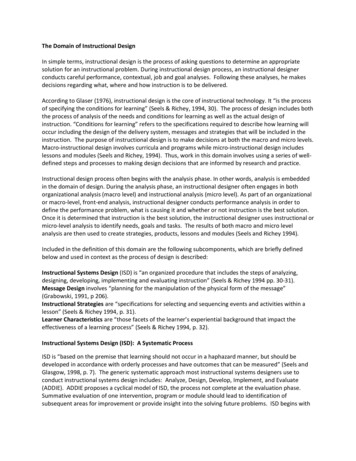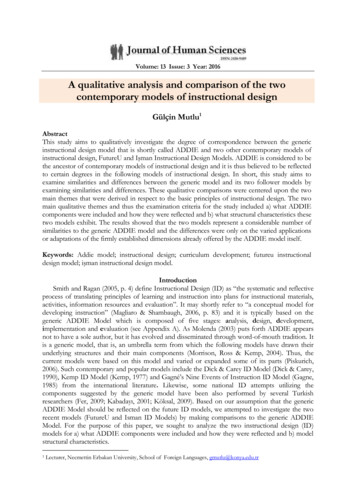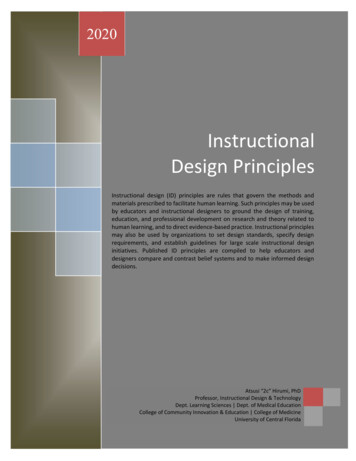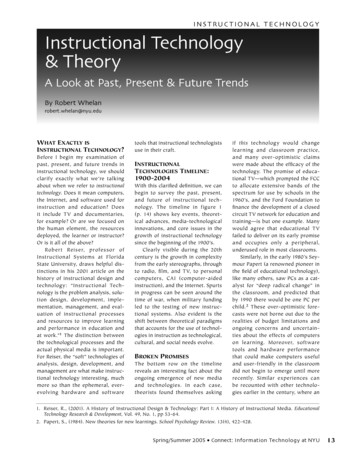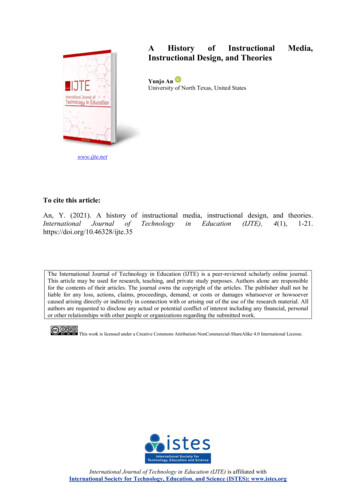
Transcription
AHistoryofInstructionalInstructional Design, and TheoriesMedia,Yunjo AnUniversity of North Texas, United Stateswww.ijte.netTo cite this article:An, Y. (2021). A history of instructional media, instructional design, and theories.InternationalJournalofTechnology in Education(IJTE),4(1), 1-21.https://doi.org/10.46328/ijte.35The International Journal of Technology in Education (IJTE) is a peer-reviewed scholarly online journal.This article may be used for research, teaching, and private study purposes. Authors alone are responsiblefor the contents of their articles. The journal owns the copyright of the articles. The publisher shall not beliable for any loss, actions, claims, proceedings, demand, or costs or damages whatsoever or howsoevercaused arising directly or indirectly in connection with or arising out of the use of the research material. Allauthors are requested to disclose any actual or potential conflict of interest including any financial, personalor other relationships with other people or organizations regarding the submitted work.This work is licensed under a Creative Commons Attribution-NonCommercial-ShareAlike 4.0 International License.International Journal of Technology in Education (IJTE) is affiliated withInternational Society for Technology, Education, and Science (ISTES): www.istes.org
International Journal of Technology in Education2021, Vol. 4, No. 1, 1-21https://doi.org/10.46328/ijte.35A History of Instructional Media, Instructional Design, and TheoriesYunjo AnArticle InfoAbstractArticle HistoryThis paper discusses the history of the instructional design and technology fieldReceived:in four major time periods: (1) 1900s – 1930s, (2) World War II – 1970s, (3)9 March 20201980s – 1990s, and (4) 21st century. Since the 20th century has been discussed inAccepted:2 July 2020detail in earlier works, this paper puts more focus on the 21st century section,which includes discussions of social media, online and blended learning, mobilelearning, the open educational resource (OER) movement, massive open onlinecourses (MOOCs), virtual reality (VR) and augmented reality (AR), digitalKeywordsHistoryInstructional mediagame-based learning (DGBL), gamification, the maker movement, newinstructional design process models, and instructional-design theory. WhileInstructional designprevious discussions of the history of the field focused on the history ofLearning theoriesinstructional media and instructional design and the evolution of learningInstructional-design theoriestheories, this paper includes the discussion of the evolution of instructionaldesign theories and models, which have received relatively less attention.IntroductionLearning history allows us to better understand our current state and provides insights into the future. In order tobetter understand the current trends and issues in the instructional design and technology field and makeinformed predictions about its future, it is critical to understand how the field has evolved. Many scholars havediscussed the history of instructional design and technology (e.g., Molenda, 2008; Reiser, 2001a, 2001b, 2018;Saettler, 1968, 1990) focusing mainly on the history of the field in the 20th century. In this paper, the history ofthe field is discussed in four major time periods: (1) 1900s – 1930s, (2) World War II – 1970s, (3) 1980s –1990s, and (4) 21st century. Since the 20th century has been discussed in detail in earlier works, this paper putsmore focus on the 21st century section. While previous discussions of the history of instructional design andtechnology focused on the history of instructional media and instructional design and the evolution of learningtheories, this paper includes the discussion of the evolution of instructional-design theories and models, whichhave received relatively less attention. It should be noted that this paper focuses on major events in the UnitedStates.1900s-1930sThe Visual Instruction MovementIn the early part of the twentieth century when school museums, the equivalent of district-wide media center,1
Ancame to existence, most of the media housed in school museums were visual media, such as photographs, slides,and films. The increasing interest in using visual media in education was referred to as the visual instructionmovement (Reiser, 2018; Saettler, 1990). In 1913, Thomas Edison envisioned that school systems would becompletely changed with visual media in the next ten years, proclaiming: ―Books will soon be obsolete in theschools . It is possible to teach every branch of human knowledge with the motion picture‖ (cited in Saettler,1968, p. 98).Although the revolutionary changes in school systems envisioned by Edison did not happen, the visualinstruction movement did grow, resulting in five national professional organizations for visual instruction and anumber of courses and textbooks on visual instruction. Despite the growth of the visual instruction movement,teachers and textbooks were still viewed as the primary means of instruction, while the visual materials housedin school museums were viewed as supplementary materials (Reiser, 2018; Saettler, 1990). According to Cuban(1986), the impact of the visual instruction was limited due to a variety of factors, including poor instructionalquality of relevant films in many subject areas, the costs associated with purchasing and maintaining films andequipment, the difficulty teachers had in using film equipment, and teacher resistance to change.The Audiovisual Instruction MovementAs media began incorporating sound in the 1920s, the visual instruction movement was expanded to theaudiovisual instruction movement (Finn, 1972; McCluskey, 1981). Radio gained a great deal of attention, but ithad very little impact on instructional practices due to various factors including poor equipment, poor receptionof radio signals, and teacher resistance to change (Cuban, 1986; Reiser, 2018). The audiovisual instructionmovement continued to evolve despite the adverse economic effects of the Great Depression, which began in1929. The Department of Visual Instruction (DVI), which was part of the National Education Association at thattime and is now called as Association for Educational Communication and Technology (AECT), was formed in1932 (Saettler, 1990).BehaviorismBefore World War II, learners were only expected to understand and learn rudimentary skills, such as reading,writing, and arithmetic. During this time period, behaviorism dominated the psychology of learning, andbehaviorist theories were used as the basis for designing many of the early audiovisual materials (Edgar, 2012;Ertmer & Newby, 2013). Behaviorism grew with the work by Pavlov, Watson, Thorndike, and Skinner.Thorndike (1905) formalized the Law of Effect. Watson (1913) published the article ―Psychology as theBehaviorist Views It,‖ which is often called ―The Behaviorist Manifesto,‖ and claimed that psychology isthe science of human behavior, which should be studied under laboratory conditions. B. F. Skinner (1938)believed that classical conditioning was too simplistic to be used to describe complex human behavior andformulated the operant conditioning learning theory.2
International Journal of Technology in Education (IJTE)World War II – 1970sWord War II and Instructional MediaThe growth of the audiovisual instruction movement slowed in schools during World War II (WWII), but a widevariety of audiovisual materials and equipment, such as training films, film projectors, and overhead projectors,were extensively used to train U.S. military personnel and to prepare U.S. civilians to work in industry (Reiser,2018; Saettler, 1990). During the 1950s, there was an enormous growth in the use of instructional television, butmany of the instructional television projects did not last long. The interest in using television for instructionalpurposes subsided by the mid-1960s (Reiser, 2018). The term multimedia was coined in the 1950s to describeearly combinations of various media used to enhance teaching and learning (Heinich, Molenda, Russell, &Smaldino, 1999).The Behavioral Objectives MovementThe behavioral objectives movement emphasized that learning objectives should be written in observable andmeasurable terms. In the 1950s, the Taxonomy of Educational Objectives written by Benjamin Bloom and hiscolleagues gave another boost to the behavioral objectives movement (Bloom, Engelhart, Furst, Hill, &Krathwohl, 1956). In the early 1960s, Robert Mager (1962) published Preparing Objectives for ProgrammedInstruction, which described how to write objectives that include learner behaviors, conditions, and standards.The behavioral objectives are still prevalent and advocated by many instructional designers and educators.Teaching Machines, Programmed Instruction, and Computer-Assisted InstructionAlong with behavioral objectives, teaching machines, programmed instruction, and computer-assistedinstruction (CAI) were among the major works influenced by behaviorism (Saettler, 1990). Teaching machines,which were advocated by Skinner (1958), used reinforcement to increase learning. Programmed instruction,which was also advocated by Skinner, ran from the mid-1950s through the mid-1960s. Skinner (1958) statedthat programmed instruction should include behavioral objectives, present content in small steps, require activelearner response to frequent questions, allow for self-pacing, and provide immediate feedback.Many of the programmed instructional materials developed during the late 1950s through the 1960s were testedand evaluated while they were being developed. In 1967, Michael Scriven (1967) coined the term formativeevaluation and contrasted it with summative evaluation. During the 1960s and early 1970s, CAI systems such asPLATO and TICCIT, were developed even though much of the early work in CAI was done in the 1950s byresearchers at IBM (Lewis & Pask, 1965; Stolorow & Davis, 1965). However, CAI had had very little impact oneducation by the end of the 1970s (Pagliaro, 1983).Launch of Sputnik and Shift from Behaviorism to CognitivismIn 1957, when the Soviet Union launched Sputnik, the first artificial Earth satellite, the space race began.3
AnRealizing that American schools were falling behind, the United States poured millions of dollars intoimproving math and science education. The training needs of WWII and the launch of Sputnik evoked reflectionon educational systems and new questions for learning. There was an apparent need to educate people to thinkcritically, learn complex skills, and solve problems. Behavioral principles could not adequately address theacquisition of higher-level skills, and a new learning theory was needed (Edgar, 2012).Cognitivism emerged in the 1950s and surfaced as a dominant learning theory in the late 1970s (Edgar, 2012;Ertmer & Newby, 2013; Reiser, 2018). Psychologists and educators began to focus more on complex cognitiveprocesses such as reasoning, information procession, and problem solving and de-emphasize overt andobservable behavior (Snelbecker, 1983). For example, Piaget‘s theory of cognitive development proposed fourstages of cognitive development, namely sensorimotor, preoperational, concrete operational, and formaloperational stage (McLeod, 2018; Woolfolk, 2010).Instructional Design (ID)The origin of ID. The origin of the ID process can be traced back to WWII (Dick, 1987). During WWII, a largenumber of psychologists and educators, including Robert Gagné, Leslie Briggs, and John Flanagan, were calledupon to develop training materials for the military services and conduct research. Many of the psychologistscontinued to work on solving instructional problems after the war, and they started developing a number ofinnovative analysis, design, and evaluation procedures during the late 1940s and throughout the 1950s (Dick,1987; Saettler, 1990). For example, Robert Miller (1962) developed a detailed task analysis method during thisperiod.In 1962, Robert Glaser introduced the concept of instructional design (Glaser, 1962). In 1965, Robert Gagné(1965) published the first edition of The Conditions of Learning, in which he identified five major categories oflearning: verbal information, intellectual skills, cognitive strategies, motor skills, and attitudes. In the book,Gagné also described nine events of instruction (Gagné, 1965, 1985). His description of the five learningoutcomes and the events of instruction became the foundation of ID practices (Reiser, 2018).The systems approach to ID. During the 1970s, a number of scholars created new ID models for systematicallydesigning instruction (e.g., Dick & Carey, 1978; Gagne & Briggs, 1974; Gerlach & Ely, 1971; Kemp, 1971).Some of the models developed during the period, such as the Dick and Carey model, became standards in thefield and have been frequently taught to graduate students studying ID programs (Johnson, Xin, Mackal, &Reiser, 2012). In addition to ID models, many graduate programs in ID were created during the 1970s (Redfield& Dick, 1984).Theory of InstructionLittle attention was paid to instructional-design theory since most of the attention in the field of instructionaldesign was on the ID process or ID models (Reigeluth, 1983). However, the advances of instructional media and4
International Journal of Technology in Education (IJTE)learning theories contributed to the development of the instructional design theories and models. Gagné,Skinner, Bruner, Ausubel, Merrill, and Reigeluth were among the major contributors. Bruner, who developed amodel of instruction based on discovery methods, was among the first to talk about developing a ―theory ofinstruction‖ (Bruner, 1966).Reigeluth and Merrill (1978, 1979) proposed that there were three major components of a theory of instruction,which included instructional methods, instructional conditions, and instructional outcomes. Further, Reigeluthand Merrill (1979) extended the conditions-methods-outcomes framework in an attempt to identify all of theimportant kinds of method variables that should be included in a comprehensive model or a theory ofinstruction. The extended framework included three types of instructional methods: organizational, delivery, andmanagement.1980s – 1990sPersonal Computers, Hypermedia, and InternetThe interest in using computers for instructional purposes increased in the 1980s, even though computers wereused in education much earlier (Reiser, 2018). The Center for Social Organization of Schools (1983) reportedthat computers were being used in over 40 percent of elementary schools and over 75 percent of all secondaryschools in the United States by January 1983. Although schools had one computer for every nine students onaverage by 1995, the impact of computers on instructional practices were minimal. Computers were mainly usedfor drill and practice or for teaching computer skills (e.g., word processing). Many teachers reported little or nouse of computers for instructional purposes (Becker, 1998; Office of Technology Assessment, 1995; Reiser,2018).In the 1980s, the computer began to combine some of the distinct media, such as textbooks, audio, visuals, andmotion media (Heinich, Molenda, Russell, & Smaldino, 1999). Hypermedia systems, such as HyperCard, werewidely used in schools. Hypermedia refers to ―computer software that uses elements of text, graphics, video,and audio connected in such a way that the user can easily move within the information‖ (Heinich, Molenda,Russell, & Smaldino, 1999, p. 230). Based on cognitive theories, hypermedia was designed to resemble the waypeople organize information with concepts and their relationships. In the 1990s, research on the use ofhypermedia for learning was active (e.g., Dillan & Gabbard, 1998; Weller, Repman, Lan, & Rooze, 1995). It isworth noting that the terms hypermedia, multimedia, and interactive video were often used interchangeably inthe literature (Liao, 1999).The World Wide Web became publicly available in 1991. According to the National Center for EducationStatistics, 65 percent of all public schools had access to the Internet in the fall of 1996, and dial-up Internetconnections were used by about 74 percent of public schools having Internet access in 1996 (Heaviside,Riggins, & Farris, 1997). The Internet changed the ways of teaching and learning by providing learners withimmediate access to information.5
AnDistance Education/Online EducationAlthough distance education was common in the late 1800s in the form of correspondence education, its rapidgrowth began in the late 1990s with the advance of online technologies. Shortly after the World Wide Web wasunveiled in 1991, universities and colleges began experimenting with online courses (Kentnor, 2015). In 1998,nonprofit institutions sought to increase revenues by entering into the online marketplace. For example, NewYork University (NYU) created NYU Online in 1998. NYU was the first large nonprofit university to create afor-profit online education subsidiary (Arenson, 1998a). Western Governors University, a nonprofit onlineuniversity, was founded in the same year in order to make education more accessible. The California VirtualUniversity opened in November of 1998 (Arenson, 1998b). Since its inception in the 1700s, distance educationhas made education more accessible and attainable for those who are unable to sit in traditional classrooms.The Clark-Kozma DebateMost research on instructional media from the 1920s through the 1960s focused on media comparisons. In the1980s, Richard Clark and Robert Kozma started the famous media debate. After reviewing the results of studiesand meta-analyses of research comparing the effectiveness of various media, Clark (1983) claimed that "mediaare mere vehicles that deliver instruction but do not influence student achievement any more than the truck thatdelivers our groceries causes changes in our nutrition" (p. 445). Kozma (1994) argued that ".Clark's separationof media from method creates an unnecessary and undesirable schism between the two. Medium and methodshould have a more integral relationship" (p.16). He suggested moving from "Do media influence learning?" to"In what ways can we use the capabilities of media to influence learning for particular students, tasks, andsituations?" The debate between Clark and Kozma has instigated much discussion and debate on whether or notmedia influences learning.Instructional Design (ID) and Human Performance ImprovementInterest in the ID process continued to grow during the 1980s and remained strong especially in business,industry, and the military. However, ID had minimal impact on instructional practices in K-12 schools and inhigher education (Reiser, 2018). In 1986, the International Board of Standards for Training, Performance, andInstruction (ibstpi) published the first set of instructional design competencies. The ibstpi revised the IDcompetences in the year 2000 and more recently in 2012, in response to changing learning environments andnew expectations for instructional designers (Koszalka, Russ-Eft, & Reiser, 2013).In the 1990s, instructional designers began to take an interest in using computers as tools to improve on-the-jobperformance as well as to enhance learning. The human performance improvement movement broadened thescope of the ID field and led instructional designers to consider and identify non-instructional interventions(Reiser, 2018). During this decade, an interest in using electronic performance support systems (EPSS) andknowledge management systems to support learning and on-the-job performance began to flourish (Gery, 1991;Schwen, Kalman, Hara, & Kisling, 1998).6
International Journal of Technology in Education (IJTE)Constructivism and ConstructionismIn the 1980s and 1990s, the growing interest in constructivist views of teaching and learning was another majortrend in the instructional design field. Constructivists viewed learning as an active process of constructing ratherthan acquiring knowledge. Therefore, instruction was viewed as a process to support the construction rather thancommunication of knowledge (Duffy & Cunningham, 1996). Many scholarly works focused on topics related toconstructivist learning including cognitive apprenticeship (Collins, Brown, &Newman, 1989), problem-basedlearning (Savery & Duffy, 1995), problem solving (Jonassen, 1997), cognitive load during problem solving(Sweller, 1988), learning by doing (Schank, 1994), teaching complex cognitive skills (van Merriënboer, 1997),and designing constructivist learning environments (Jonassen, 1999).In the1980s, Papert (1993a, b) developed constructionism, which suggested that learning is most effective whenstudents are actively engaged in the construction of concrete and meaningful artifacts. In his books, Mindstormsand The Children’s Machine, Papert suggested that the computer should be an ―object to think with,‖ not adispenser of information. Like constructivists, he agreed that knowledge is actively constructed by learnersrather than transmitted by a teacher. However, Papert believed that the construction of concrete artifacts orproducts ‗‗in the world‘‘ could support the construction of knowledge ‗‗in the head,‘‘ while Piaget‘sconstructivist theory focused on the construction of knowledge in one‘s head (Harel & Papert, 1991). Papert‘sconstructionism has recently gained increasing attention through the maker movement, which is discussed in the21st Century section below.Instructional-Design TheoryIn the 1980s and 1990s, the awareness of and interest in instructional-design theories increased with Reigeluth‘sbooks on instructional-design theories and models. In the early 1980s, Reigeluth (1983) published the firstvolume, Instructional-Design Theories and Models: An Overview of their Current Status. The main purpose ofthe first volume was to raise awareness of instructional-design theories, which were largely overlooked in theshadows of ID process models.Pointing out that instructional design is a prescriptive science, Reigeluth (1983) distinguished instructionaldesign theory from learning theory and instructional development in the first chapter of the first volume.Further, he emphasized that the focus of an instructional-design theory was on methods of facilitating learningrather than on processes of learning within a person‘s head. The first volume summarized some famous modelsand theories of instruction, including Merrill‘s Component Display Theory (CDT), Reigeluth‘s ElaborationTheory, and Keller‘s Motivational Design Model.Reigeluth‘s (1999a) second volume, Instructional-Design Theories and Models: A New Paradigm ofInstructional Theory, was published in 1999. In the first chapter, Reigeluth (1999b) defined an instructionaldesign theory as ―a theory that offers explicit guidance on how to better help people learn and develop‖ (p. 5)and described characteristics and components of instructional-design theories in more detail. Emphasizing the7
Anneed for a new paradigm of instructional-design theory, the second volume introduced various instructionaldesign theories and models that provided customized and learner-centered learning experiences, includingSchank‘s Learning by Doing, Bransford‘s Flexibly Adaptive Instructional Designs, and Jonassen‘sConstructivist Learning Environments (CLE).Reigeluth‘s work on instructional-design theory has made several contributions to the instructional design andtechnology field. First, he increased awareness of instructional-design theory by defining it and distinguishing itfrom learning theory and instructional development. Second, he encouraged and facilitated the development ofinstructional-design theory by specifying the components of instructional-design theories, providing a numberof examples, and offering guidance for the theory-development process (Reigeluth, 1983, 1999a). Third, heintroduced researchers, practitioners, and graduate students to a wide variety of instructional-design theories.Finally, he made a significant impact on the paradigm shift from teacher-centered to learner-centered educationby emphasizing the need for this new paradigm of instructional-design theory and demonstrating many differentways to provide customized and learner-centered learning experiences (Reigeluth, 1999).21st CenturySocial MediaToday, there are a number of social media sites. Some popular social media, including Facebook, YouTube, andTwitter, were launched in the 2000s (Boyd & Ellison, 2008). Social media refer to Web 2.0 technologiescharacterized by openness, user participation, user-created content, knowledge sharing, and social interaction(Alexander, 2006; Bingham, & Conner, 2010; Brown & Adler, 2008; Dao, 2015; Downes, 2005; Richardson,2009; Thompson, 2007). While Web 1.0 was read-only, Web 2.0 is read/write and allows users to become activeparticipants and content creators. They not only find information on the Internet, but they also create andpublish content online and network with other people from all over the world.Web 2.0 has ―blurred the line between producers and consumers of content and has shifted attention from accessto information toward access to other people‖ (Brown & Adler, 2008, p. 18). According to a recent PewResearch Center survey, YouTube (73%) and Facebook (69%) are the most widely used social media sitesamong adults in the U.S. There are substantial age-related differences in the use of social media platforms.Snapchat and Instagram are the most popular apps among those ages 18 to 24 (Perrin & Anderson, 2019).Social media has the potential to create learner-centered learning environments by empowering learners tobecome knowledge creators and producers and providing opportunities for interaction and collaboration(Downes, 2005; Gikas & Grant, 2013; Greenhow, 2011; Richardson, 2009). The use of social media ineducation is increasing but still limited and restricted (Manca & Ranieri, 2016). Moran, Seaman, and Tinti-Kane(2011) found that over 90% of higher education faculty were using social media in their courses. However, theuse of social media was limited primarily to online videos. Research studies show that some educators arehesitant to integrate social media into their teaching practices (Manca & Ranieri, 2016; Zachos,Paraskevopoulou-Kollia, & Anagnostopoulos, 2018).8
International Journal of Technology in Education (IJTE)Online and Blended LearningOnline learning is one of the fastest growing areas in the ID field. Over the last decade, it has become popularbecause of its potential to make learning more accessible and flexible. In the fall of 2008, over 4.6 millionstudents – over one quarter of U.S. higher education students – were taking at least one online course (Allen &Seaman, 2010). In the corporate world, about 33% of training was delivered electronically in 2007 (Paradise,2008). Although the adoption of online learning in K-12 settings was slower compared to other settings, onlinelearning in K-12 schools is increasing rapidly. The surveys commissioned by the Sloan Consortium (now knownas the Online Learning Consortium) reported that 700,000 K-12 public school students took online courses in2007-2008 (Picciano & Seaman, 2007, 2008). The Florida Virtual School, the largest state virtual school, hadmore than 150,000 course enrollments in 2008-2009 (Watson, Gemin, Ryan & Wicks, 2009). In 2017-18, nearly300,000 students were enrolled in 501 full-time virtual schools (Molnar, 2019). Recently, the COVID-19pandemic has forced K-12 schools and universities to move to online learning. The biggest online learningexperiment in history began in the spring of 2020 when 90% of schools worldwide closed (UNESCO, 2020).Another major trend in the 2000s is the emergence of blended or hybrid learning that combines online and faceto-face instruction (Allen & Seaman, 2003; Graham, 2005). In 2003, the American Society for Training andDevelopment identified blended learning as one of the top ten trends to emerge in the knowledge deliveryindustry (Rooney, 2003). Blended learning has the potential to empower learners by offering them choice andflexibility about when and where they can participate in the online portion of their course (Owston, 2017).Graham, Allen, and Ure (2005) found that blended learning was used mainly for three reasons: (1) improvedpedagogy, (2) increased access and flexibility, and (3) increased cost-effectiveness.Mobile LearningAs mobile technologies and devices advance, mobile learning, which is often called m-learning, is rapidlydeveloping. Crompton (2013) defined m-learning as ―learning across multiple contexts, through social andcontent interactions, using personal electronic devices.‖ Today mobile phones have the same capabilities asmicrocomputers at a small fraction of the size. The portability, mobility, and ubiquity of mobile devicessignificantly reduce the dependence on fixed locations for learning and work, and they enable students to ―learnthe right thing at the right time at the right place‖ (Peng, Su, Chou, & Tsai, 2009, p. 175). Mobile devices alsohave the potential to provide learner-centered learning experiences that are situated, authentic, and personalized(Traxler, 2011).The Open Educational Resource (OER) MovementSince the early 2000s, the OER movement has been growing. The term OER was coined at the Forum on theImpact of Open Courseware for Higher Education in Developing Countries in 2002 (UNESCO, 2002). TheOER movement has its roots in earlier work around learning objects (Weller, 2014). It is generally agreed thatOER are ―teaching, learning, and research resources that reside in the public domain or have been released9
Anunder an intellectual property license that permits their free use and repurposing by others‖ (William and FloraHewlett Foundation, 2017). The OER Evidence Report 2013-2014 showed that although awareness of OER andCreative Commons was growing, general knowledge of well-established OER reposit
Instructional media Instructional design Learning theories Instructional-design theories . Introduction. Learning history allows us to better understand our current state and provides insights into the future. In order to better understand the current trends and issues in the instructional design and technology field and make
